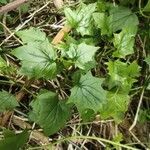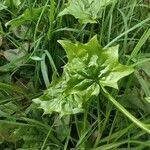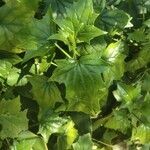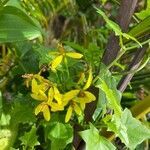A voluble much-branched herbaceous twiner, stems and leaves slightly fleshy, all parts glabrous or leaves thinly hairy below. Leaves up to c. 8 x 8 cm, more or less deltoid in outline, unequally lobed, lobes deltoid, acute with broad round sinuses, apex acute, base somewhat hastate or cuneate, petiole about as long as the blade. Heads radiate, many subumbellately or corymbosely arranged at the tips of leafy lateral branchlets. Involucre turbinate, bracts c. 6-8, 8-9 mm long, shorter than the disc, keeled, swollen at the base, nerves resinous, calyculus bracts few, small. Rays c. 5, they and the disc bright yellow, corolla lobes each with a median resinous line. Achenes c. 3.5 mm long, cylindric, ribbed, glabrous.
Climber to c. 2 m high, glabrous. Leaves to c. 12 cm long, with petiole c. half of length; lamina ± orbicular to ovate, with l:w ratio c. 1–1.5, with 1–3 lobes per side; margin entire or sparsely denticulate. Capitula several to numerous per branch; calycular bracteoles 3–5, 1–1.5 mm long, c. 0.3 mm wide; involucre 7–8 mm long, c. 2.5 mm diam.; bracts 5–8. Florets 15–20; ligulate florets 3–6; ligule 10–20 mm long, 4-veined, yellow. Achenes not seen at maturity, glabrous. Pappus ?persistent, 6–7 mm long.
Twining herb. Leaves ± deltoid in outline, unequally lobed, lobes deltoid, base hastate or cuneate, petiolate; thinly hairy below or glabrous. Heads radiate, rays 5; involucral bracts 6-8, 8-9 mm long. Achenes glabrous. Flowers bright yellow.
With orange florets, in the gardens of the National Museums of Kenya, Aug. 1965, Kirika 463!




